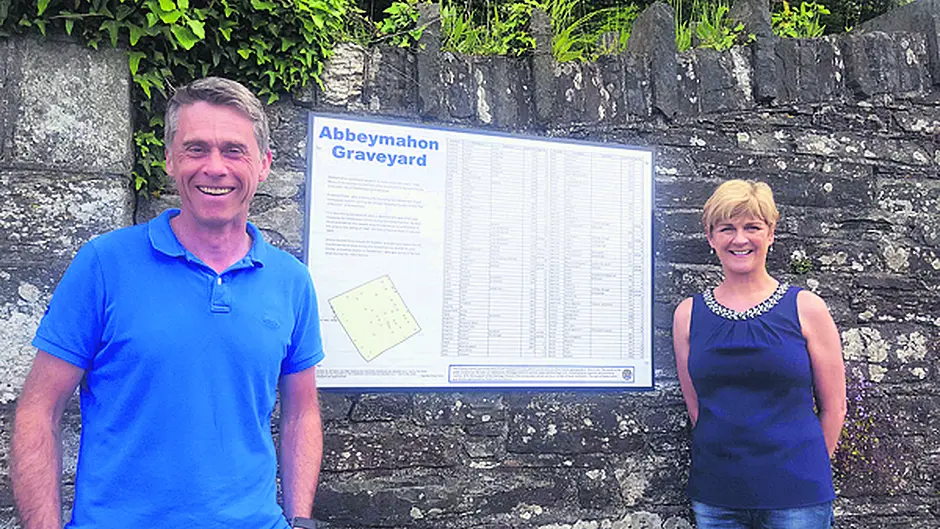A team of tireless volunteers has compiled a list of all those buried at two historic Skibbereen graveyards in a Cork County Council supported project.
A team of tireless volunteers has compiled a list of all those buried at two historic Skibbereen graveyards in a Cork County Council supported project.
INFORMATION on two important historic graveyards is now located on site at Abbeymahon and Chapel Lane Graveyards in Skibbereen.
The two new signs list those known to be interred in these burial grounds as well as giving historical information on the sites.
The signs are the second phase of the West Cork Graveyard Project which surveyed a dozen historic graveyards in this area.
A similar sign was erected in Creagh Graveyard in 2017 and it is hoped that other graveyard signs will be erected over time.
The signs are proudly supported by Cork County Council and put together by a group of volunteers: Barry McMahon, William Casey and Margaret Murphy, alongside Terri Kearney of Skibbereen Heritage Centre and Shona O’Leary and Mac Dara O h-Icí of Cork County Council.
Many of the families buried at Abbeymahon were prominent in the commercial and public life of the Skibbereen area, including the Levis, Wolfe, Vickery, Swanton and Fuller families. Some of these families still feature in the street names of Skibbereen today.
Other people of interest interred at Abbeymahon include Frederick Peel Eldon Potter, the founder of the Skibbereen Eagle newspaper – which was acquired by The Southern Star in 1929 – famously known for keeping his ‘eye on Russia’.
Fred was an extraordinary character who was an expert in propaganda publicity – or ‘fake news’ as we would call it today. Fred’s ‘eye on Russia’ phrase is known worldwide and is often still quoted in the media today.
Abbeymahon is also the burial place of John J Marshal, a Poor Law Inspector for the Skibbereen Union during the Great Famine. Marshal was responsible for setting up soup kitchens in this area in the spring and summer of 1847 and was lauded for his efficiency in so doing.
Marshal also compiled a very important document ‘A Return of Deaths and Emigrations in the western division of the Skibbereen Union, from 1 September 1846 to 12 September 1847’. This report is the only record of its kind compiled during the Great Hunger and is therefore a very valuable contribution to Famine historiography.
Like many others of those engaged in relief works in this area, Marshal contracted the ‘fever’ and died of cholera on February 2nd 1949.
Others buried at Abbeymahon include Dr Hadden, a dispensary doctor for the Castletownshend area during the Great Famine, and Richard Fair, a descendent of one of the men who escorted King Charles 1 to his execution. Dr St John Clerke, a medical doctor in Skibbereen, who was active in famine relief during the 1822 famine, is also buried in a quiet corner of Abbeymahon.
The ‘Clerke’s Crater’, an indent on the moon near the Sea of Tranquillity, is named in honour of Dr Clerke’s granddaughter, Agnes Mary Clerk, a well known astronomer. Another person of note in the graveyard is Robert Swanton, a United Irishman who fled Ireland around the time of the 1798 Rebellion.
The second graveyard, Chapel Lane, also known as Kilmahon or the ‘Chapel Yard’, is located on the site of a Mass House that served the town of Skibbereen from Penal times until the late 1820s. It’s a large graveyard and the final resting place for many of the people of Skibbereen and surrounding area.
It was used for mass burials during the Great Famine and two 1847 sketches from the newspaper The Illustrated London News relate to it.
One of them is of the watch house at the centre of this graveyard: ‘This hut is surrounded by a rampart of human bones ... in this horrible den, in the midst of human putrefaction, six individuals, labouring under the most malignant fever, were huddled together, as closely as were the dead in the graves around’.
The new sign at Chapel Lane indicates the site of this watch house, which no longer exists.
Terri Kearney of Skibbereen Heritage Centre, who was involved in the unique project, said there had been a great reaction to it so far.
‘We have had many visitors at Skibbereen Heritage Centre who have said that they found their ancestors’ grave on our website before deciding to come to Ireland.
‘For many of them, this is the only tangible link to their ancestry and is therefore very precious to them. But we have had a fantastic response from the people of Skibbereen too, as locals came forward with more information on those interred in these graveyards.’
She said they were honoured to record this information and make it available to people.
These historic sites in Skibbereen, featuring the new signs, are open to visitors, or the public can access the survey online at www.skibbheritage.com.









